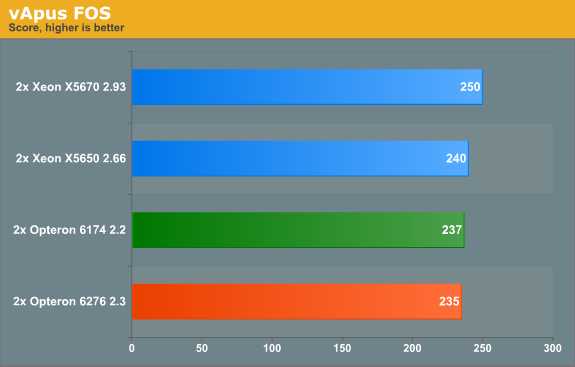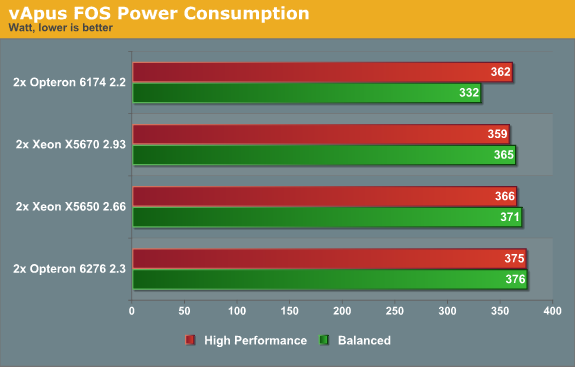Bulldozer for Servers: Testing AMD's "Interlagos" Opteron 6200 Series
by Johan De Gelas on November 15, 2011 5:09 PM ESTVirtualization Performance: Linux VMs on ESXi
We introduced our new vApus FOS (For Open Source) server workloads in our review of the Facebook "Open Compute" servers. In a nutshell, it a mix of four VMs with open source workloads: two PhpBB websites (Apache2, MySQL), one OLAP MySQL "Community server 5.1.37" database, and one VM with VMware's open source groupware Zimbra 7.1.0. Zimbra is quite a complex application as it contains the following components:
- Jetty, the web application server
- Postfix, an open source mail transfer agent
- OpenLDAP software, user authentication
- MySQL is the database
- Lucene full-featured text and search engine
- ClamAV, an anti-virus scanner
- SpamAssassin, a mail filter
- James/Sieve filtering (mail)
All VMs are based on a minimal CentOS 5.6 setup with VMware Tools installed. All our current virtualization testing is on top of the hypervisor which we know best: ESXi (5.0). CentOS 5.6 is not ideal for the Interlagos Opteron, but we designed the benchmark a few months ago. It took us weeks to get this benchmark working and repeatable (especially the latter is hard). For example it was not easy to get Zimbra fully configured and properly benchmarked due to the complex usage patterns and high I/O usage. Besides, the reality is that VMs often contain older operating systems. We hope to show some benchmarks based on Linux kernel version 3.0 or later in our next article.
We tested with five tiles (one tile = four VMs). Each tile needs seven vCPUs, so the test requires 35 vCPUs.

The Opteron 6276 stays close to the more expensive Xeons. That makes the Opteron server the one with the best performance per dollar. Still, we feel a bit underwhelmed as the Opteron 6276 fails to outperform the previous Opteron by a tangible margin.
The benchmark above measures throughput. Response times are even more important. Let us take a look at the table below, which gives you the average response time per VM:
| vApus FOS Average Response Times (ms), lower is better! | ||||||||
| CPU | PhpBB1 | PHPBB2 | MySQL OLAP | Zimbra | ||||
| AMD Opteron 6276 | 737 | 587 | 170 | 567 | ||||
| AMD Opteron 6174 | 707 | 574 | 118 | 630 | ||||
| Intel Xeon X5670 | 645 | 550 | 63 | 593 | ||||
| Intel Xeon X5650 | 678 | 566 | 102 | 655 | ||||
The Xeon X5670 wins a landslide victory in MySQL. MySQL has always scaled better with clock speed than with cores, so we expect that clock speed played a major role here. The same is true for our first VM: this VM gets only one CPU and as result runs quicker on the Xeon. In the other applications, the Opteron's higher (integer) core count starts to show. However, AMD cannot really be satisfied with the fact that the old Opteron 6174 delivers much better MySQL performance. We suspect that the high latency L2 cache and higher branch misprediction penalty (20 vs 12) is to blame. MySQL performance is characterized by a relatively high amount of branches and a lot of accesses to the L2. The Bulldozer server does manage to get the best response time on our Zimbra VM, however, so it's not a complete loss.
Performance per watt remains the most important metric for a large part of the server market. So let us check out the power consumption that we measured while we ran vApus FOS.

The power consumption numbers are surprising to say the least. The Opteron 6174 needs quite a bit less energy than the two other contenders. That is bad news for the newest Opteron. We found out later that some tinkering could improve the situation, as we will see further.










106 Comments
View All Comments
DigitalFreak - Tuesday, November 15, 2011 - link
Good to see that CPU-Z correctly reports the 6276 as 8 core, 16 thread, instead of falling for AMD's marketing BS.N4g4rok - Tuesday, November 15, 2011 - link
If each module possess two integer cores to a shared floating point core, what's to say that it can't be considered as a practical 16 core?phoenix_rizzen - Tuesday, November 15, 2011 - link
Each module includes 2x integer cores, correct. But the floating point core is "shared-separate", meaning it an be used as two separate 128-bit FPUs or as a single 256 FPU.Thus, each Bulldozer module can run either 3 or 4 threads simultaneously:
- 2x integer + 2x 128-bit FP threads, or
- 2x integer + 1x 256-bit FP threads
It's definitely a dual-core module. It's just that the number of threads it can run is flexible.
The thing to remember, though, is that these are separate hardware pipelines, not mickey-moused hyperthreaded pipelines.
JohanAnandtech - Tuesday, November 15, 2011 - link
You can get into a long discussion about that. The way that I see it, is that part of the core is "logical/virtual", the other part is real in Bulldozer . What is the difference between an SMT thread and CMT thread when they enter the fetch-decode stages? Nothing AFAIK, both instructions are interleaved, and they both have a "thread tag".The difference is when they are scheduled, the instructions enters a real core with only one context in the CMT Bulldozer. With SMT, the instructions enter a real core which still interleave two logical contexts. So the core still consists of two logical cores.
It is gets even more complicated when look at the FP "cores". AFAIK, the FP cores of Interlagos are nothing more than 8 SMT enabled cores.
alpha754293 - Tuesday, November 15, 2011 - link
I think that Johan is partially correct.The way I see it, the FPU on the Interlagos is this:
It's really a 256-bit wide FPU.
It can't really QUITE separate the ONE physical FPUs into two 128-bit wide FPUs, but it more probably in reality, interleaves them (which is really just code for "FPU-starved").
Intel's original HTT had this as a MAJOR problem, because the test back then can range from -30% to +30% performance increase. Floating-point intensive benchmarks have ALWAYS suffered mostly because suppose you're writing a calculator using ONLY 8-byte (64-bit) double precision.
NORMALLY, that should mean that you should be able to crunch through four DWORDs at the same time. And that's kinda/sorta true.
Now, if you are running two programs, really...I don't think that the CPU, the compiler (well..maybe), the OS, or the program knows that it needs to compile for 128-bit-wide FPUs if you're going to run two instances or two (different) calculators.
So it's resource starved in trying to do the calculation processes at the same time.
For non-FPU-heavy workloads, you can get away with that. For pretty much the entire scientific/math/engineering (SME) community; it's an 8-core processor or a highly crippled 16-core processor.
Intel's latest HTT seems to have addressed a lot of that, and in practical terms, you can see upwards of 30% performance advantage even with FPU-heavy workloads.
So in some cases, the definition of core depends on what you're going to be doing with it. For SME/HPC; it's good cuz it can do 12-actual-cores worth of work with 8 FPUs (33% more efficient), but sucks because unless they come out with a 32-thread/16-core monolithic die; as stated, it's only marginally better than the last. It's just cheaper. And going to get incrementally faster with higher clock speeds.
alpha754293 - Tuesday, November 15, 2011 - link
P.S. Also, like Anand's article about nVidia Optimus:Context switching even at the CPU level, while faster, is still costly. Perhaps maybe not nearly as costly as shuffling data around; but it's still pretty costly.
Samus - Wednesday, November 16, 2011 - link
Ouch, this is going to be AMD's Itanium. That is, it has architecture adoption problems that people simply won't build around. Maybe less substantial than IA64, but still a huge performance loss because of underutilized integer units.leexgx - Wednesday, November 16, 2011 - link
think they way CPU-z reporting it for BD cpus is correct each core has 2 FP, so 8 cores and 16 threads is correctto bad windows does not understand how to spread the load correctly on an amd cpu (windows 7 with HT cpus Intel works fine, spreads the load correctly, SP1 improves that more but for Intel cpus only)
windows 7 sp1 makes biger use of core parking and gives better cpu use on Intel cpus as i have been seeing on 3 systems most work loads now stay on the first 2 cores and the other 2 stay parked, on amd side its still broke with cool and quite enabled
Stuka87 - Tuesday, November 15, 2011 - link
So, what is your definition of a core?Bulldozers do not utilize hyper threading, which takes a single integer core and can at times put two threads into that single integer core. A Bulldozer core has actual hardware two run two threads at the same time. This would suggest there are two physical cores.
Does it perform like an intel 16 core (if there was such a thing), no. But that does not mean that it is not in fact a 16 core device. As the hardware is there. Yes they share an FPU, but that doesn't mean they are not cores.
Filiprino - Tuesday, November 15, 2011 - link
Actually, Bulldozer is 16 cores. It has two dedicated integer units and a float point unit which can act as two 128 bit units or one 256 bit unit for AVX. So, you can have 2 and 2 per module.Bulldozer does not use hyperthreading.